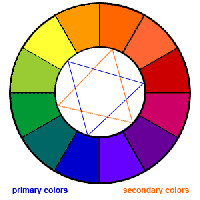What is color?
One of the most striking properties about life is that it has color.
To understand the phenomenon of color, it helps to think about light as a wave.
But, before we get to that, let's talk a little bit about waves in general. Imagine you're sitting on a boat on the ocean watching a cork bob up and down in the water. The first thing you notice about the motion is that it repeats itself.
The cork traces the same path over and over again... up and down, up and down.
This repetitive or periodic motion is characteristic of waves.
Then you notice something else... using a stopwatch, you measure the time it takes for the piece of cork to go over its highest position down to its lowest and then back up again. Suppose this takes two seconds.
To use the physics jargon, you've measured the period of the waves that cork is bobbing on. That is, how long it takes a wave to go through its full range of motion once.
The same information can be expressed in a different way by calculating the wave's frequency. Frequency, as the name suggest, tells you how frequent the waves are.
That is, how many of them go by in one second.
If you know how many seconds one full wave takes, then it's easy to work out how many waves go by in one second. In this case, since each wave takes 2 seconds, the frequency is 0.5 waves per second.
So enough about bobbing corks... what about light and color?
If light is a wave, then it must have a frequency. Right?
Well... yes, it does.
And it turns out that we already have a name for the frequency of the light that our eyes detect.
It's called color. That's right. Color is nothing more than a measure of how quickly the light waves are waving.
If our eyes were quick enough, we might be able to observe this periodic motion directly, like we can with the cork and the ocean. But the frequency of the light we see is so high, it waves up and down about 400 million million times a second, that we can't possibly see it as a wave. But we can tell, by looking at its color, what its frequency is.
The lowest frequency light that we can see is red and the highest frequency is purple.
In between all the other frequencies form a continous band of color, called the visible spectrum.
So, what if you had a yellow pencil sitting on your desk?
Well, the sun emits all colors of light, so light of all colors is hitting your pencil.
The pencil looks yellow because it reflects yellow light more than it reflects the other colors.
What happens to the blue, purple and red light?
They get absorbed and the energy they are carrying is turned into heat.
It is similar with objects of other colors.
Blue things reflect blue light, red things reflect red light and so on.
White objects reflect all colors of light, while black things do exactly the opposite and absorb at all frequencies. This - by the way - is why it's uncomfortable to wear your favorite Metallica t-shirt on a sunny day.

